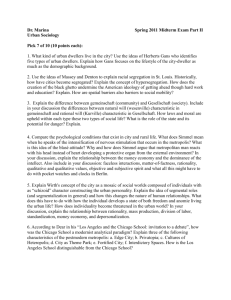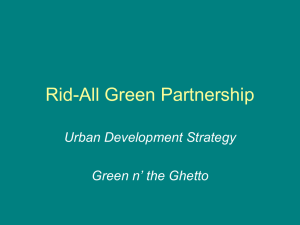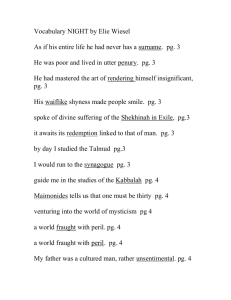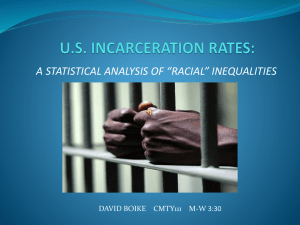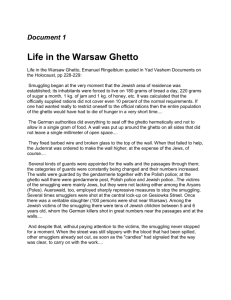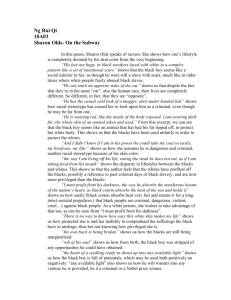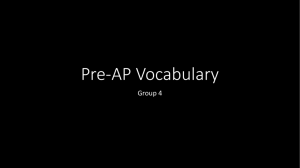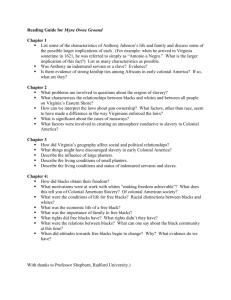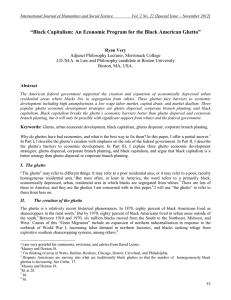6/24 – Race and Social Control (Wacquant)
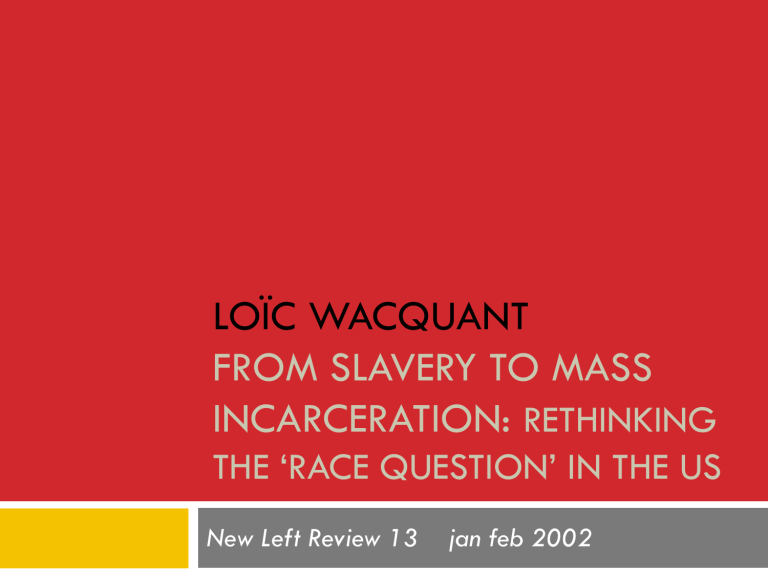
LOÏC WACQUANT
FROM SLAVERY TO MASS
INCARCERATION: RETHINKING
THE ‘RACE QUESTION’ IN THE US
New Left Review 13 jan feb 2002
2
Social control of African Americans historically managed by several institutions
Institution Form of labor Core of economy Dominant social type
Slavery
(1619-1865)
Jim Crow
(South, 1865-1965)
Ghetto
(North, 1915-1968)
Hyperghetto &
Prison (1968 -) unfree fixed labor Plantation free fixed labor Agrarian & extractive free mobile labor Segmented industrial manufacturing fixed surplus labor Polarized postindustrial services slave sharecropper menial worker welfare recipient & criminal
3
1.
2.
3.
Racial disproportionality in US imprisonment
The ethnic composition of the inmate population has flipped, going from about 70% white at the midcentury point to less than 30% today
The white-black arrest gap has remained stable while the incarceration gap has grown rapidly in the past quarter-century, jumping from 1 for 5 in 1985 to about 1 for 8 today
The lifelong cumulative probability of ‘doing time’ in a state or federal prison based on the imprisonment rates of the early 90s is 4% for whites, 16% for
Latinos and a staggering 29% for blacks
4
Mass incarceration of blacks serves
“extra-penological” functions
1.
2.
Beyond controlling crime, incarceration has
Economic function: to extract labor
Symbolic function: to “make race,” to maintain the caste division between whites and blacks
“Not crime, but the need to shore up an eroding caste cleavage, along with buttressing the emergent regime of desocialized wage labor to which most blacks are fated by virtue of their lack of marketable cultural capital, and which the most deprived among them resist by escaping into the illegal street economy, is the main impetus behind the stupendous expansion of America’s penal state in the post-
Keynesian age and its de facto policy of ‘carceral affirmative action’ towards African-Americans” (p. 44)
“Race” and Racism
5
“The term race stands for the conception or the doctrine that nature produced humankind in distinct groups, each defined by inborn traits that its members share and that differentiate them from members of other distinct groups of the same kind but of unequal rank…Race is the principle unit and core concept of racism“ (pp. 16-17).
“Racism refers to the theory and the practice of applying a social, civic or legal double standard based on ancestry, and to the ideology of such a double standard (p. 17)
[B. Fields and K. Fields, Racecraft: The Soul of Inequality in American Life , Verso, 2012]
“Americans of European descent invented race during the era of the
American Revolution as a way of resolving the contradiction between a natural right to freedom and the fact of slavery.”
[B. Fields, Race: The
Power of an Illusion, PBS http://www.pbs.org/race/000_About/002_04-background-02-
02.htm]
I. Slavery (1619–1865)
6
Slavery was geared primarily to the provision and control of labor
An unintended by-product of the systematic enslavement and dehumanization of Africans and their descendants was the creation of a racial caste line separating what would later become labelled “blacks” and “whites.”
“As Barbara Fields has shown, the American ideology of
‘race’, as putative biological division anchored by the inflexible application of the ‘one-drop rule’ together with the principle of hypodescent, crystallized to resolve the blatant contradiction between human bondage and democracy” (p. 45)
First, there was slavery, then “race”
II. Jim Crow (South, 1865–1965)
7
The need to secure the labor of former slaves and to sustain the status distinction between whites and blacks resulted in a range of social and legal codes separating the ‘races’ and limiting the life chances of African-Americans, while subordinating them to whites through legal coercion and terroristic violence
III. Ghetto (North, 1915–68)
8
Blacks who had migrated to the North “remained locked in a precarious position of structural economic marginality and consigned to a secluded and dependent microcosm, complete with its own internal division of labor, social stratification, and agencies of collective voice and symbolic representation”
The ghetto functioned to extract black labor while
“keeping black bodies at a safe distance, to the material and symbolic benefit of white society”
IV. Hyperghetto & Prison (1968–)
9
“It does not carry out a positive economic mission of recruitment and disciplining of the workforce: it serves only to warehouse the precarious and deproletarianized fractions of the black working class, be it that they cannot find employment owing to a combination of skills deficit, employer discrimination and competition from immigrants, or that they refuse to submit to the indignity of substandard work in the peripheral sectors of the service economy—what ghetto residents commonly label ‘slave jobs.’”
Ghetto as Prison, Prison as Ghetto
10
The ghetto: “essentially a sociospatial device that enables a dominant status group in an urban setting simultaneously to ostracize and exploit a subordinate and stigmatized group”
The ghetto: “a relation of ethnoracial control and closure built out of four elements: (i) stigma; (ii) constraint; (iii) territorial confinement; and (iv) institutional encasement”
“The ghetto, in short, operates as an ethnoracial prison: it encages a dishonoured category and severely curtails the life chances of its members in support of the ‘monopolization of ideal and material goods or opportunities’ by the dominant status group dwelling on its outskirts” (p. 51)
“Race making”
11
“Slavery, the Jim Crow system and the ghetto are ‘race making’ institutions, which is to say that they do not simply process an ethnoracial division that would somehow exist outside of and independently from them.
Rather, each produces (or co-produces) this division
(anew) out of inherited demarcations and disparities of group power and inscribes it at every epoch in a distinctive constellation of material and symbolic forms.”
These institutions reinterpret an arbitrary, socially created boundary as a biological difference – this is a myth
Criminalization of young, black males
12
“Throughout the urban criminal justice system, the formula ‘Young + Black + Male’ is now openly equated with ‘probable cause’ justifying the arrest, questioning, bodily search and detention of millions of African-
American males every year” (p. 56).
“When ‘to be a man of colour of a certain economic class and milieu is equivalent in the public eye to being a criminal’, being processed by the penal system is tantamount to being made black, and ‘doing time’ behind bars is at the same time ‘marking race’” (p. 57).
“Social death”
13
1.
2.
3.
Today’s inmates are thus the target of a threefold movement of exclusionary closure:
Denied access to valued cultural capital, e.g., Pell
Grants for education excluded from social redistribution and public aid, e.g., welfare payments, veterans’ benefits, food stamps, Medicaid, public housing, Section 8 vouchers banned from political participation via criminal
disenfranchisement, e.g., voting rights
14
Social boundary maintenance via the criminal justice system
The criminal justice system maintans a boundary between “praiseworthy ‘working families’--implicitly white, suburban, and deserving--and the despicable
‘underclass’ of criminals, loafers, and leeches, a two-headed antisocial hydra personified by the dissolute teenage ‘welfare mother’ on the female side and the dangerous street ‘gang banger’ on the male side--by definition dark-skinned, urban and undeserving” (p. 60)
Is the US a “prison society”?
15
“The astronomical overrepresentation of blacks in houses of penal confinement and the increasingly tight meshing of the hyperghetto with the carceral system suggests that, owing to America’s adoption of mass incarceration as a queer social policy designed to discipline the poor and contain the dishonoured, lower-class African-Americans now dwell, not in a society with prisons as their white compatriots do, but in the first genuine prison society in history” (p. 60)
Prison-Ghetto
16
the prison as a judicial ghetto: a jail or penitentiary is in effect a reserved space which serves to forcibly confine a legally denigrated population and wherein this latter evolves its distinctive institutions, culture and sullied identity. It is thus formed of the same four fundamental constituents—stigma, coercion, physical enclosure and organizational parallelism and insulation—that make up a ghetto, and for similar purposes.”
“Finally, both prison and ghetto are authority structures saddled with inherently dubious or problematic legitimacy whose maintenance is ensured by intermittent recourse to external force.”
